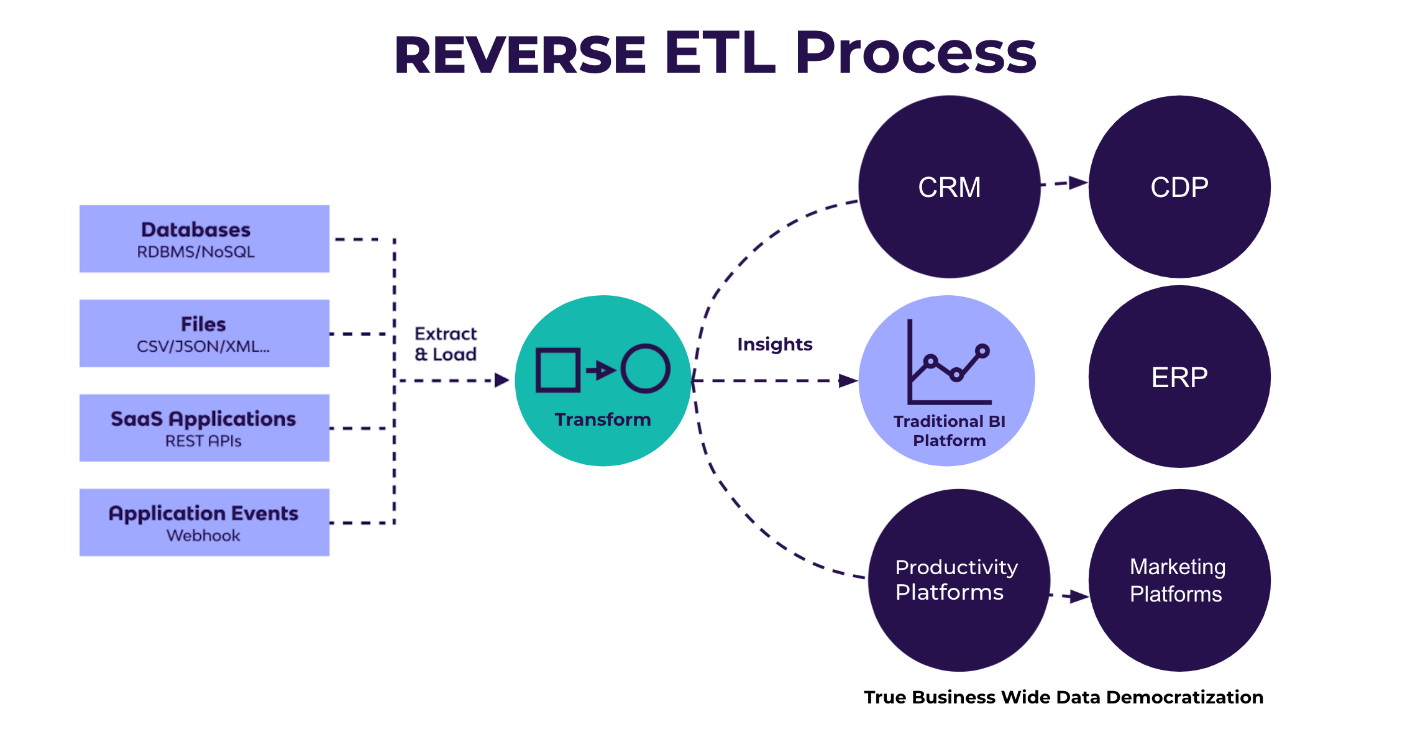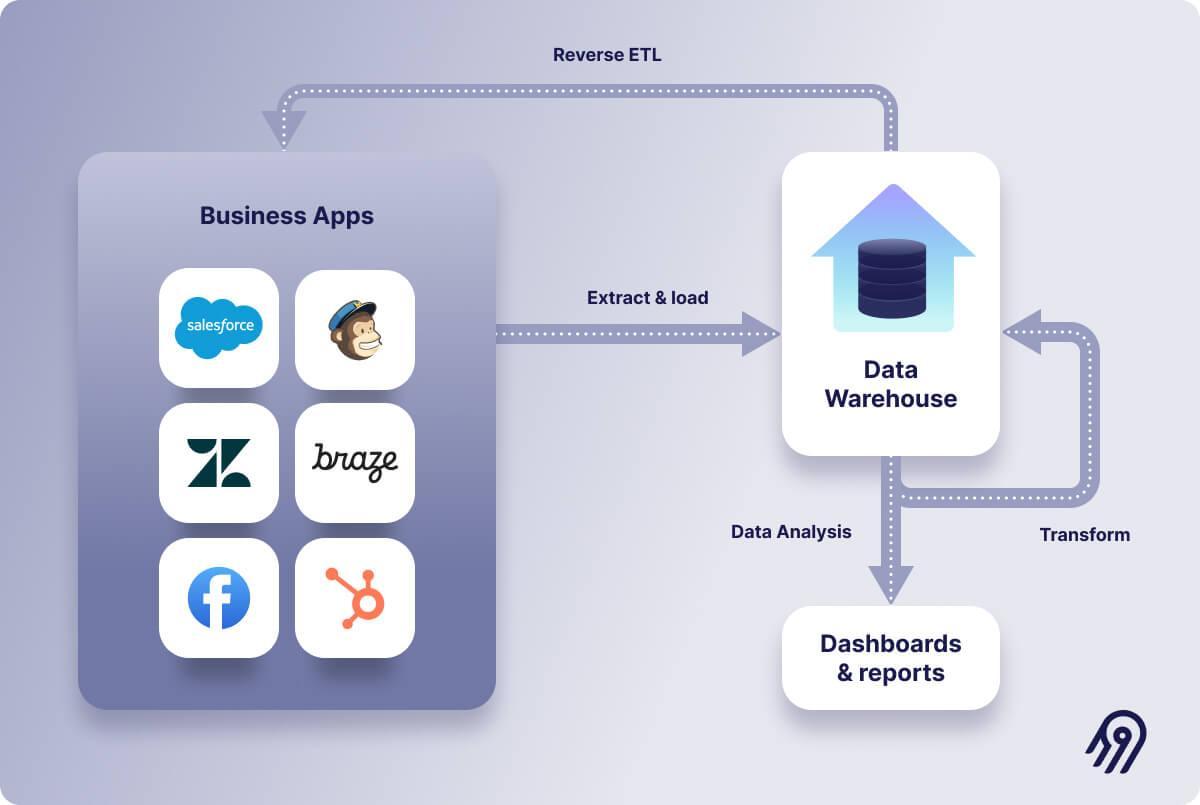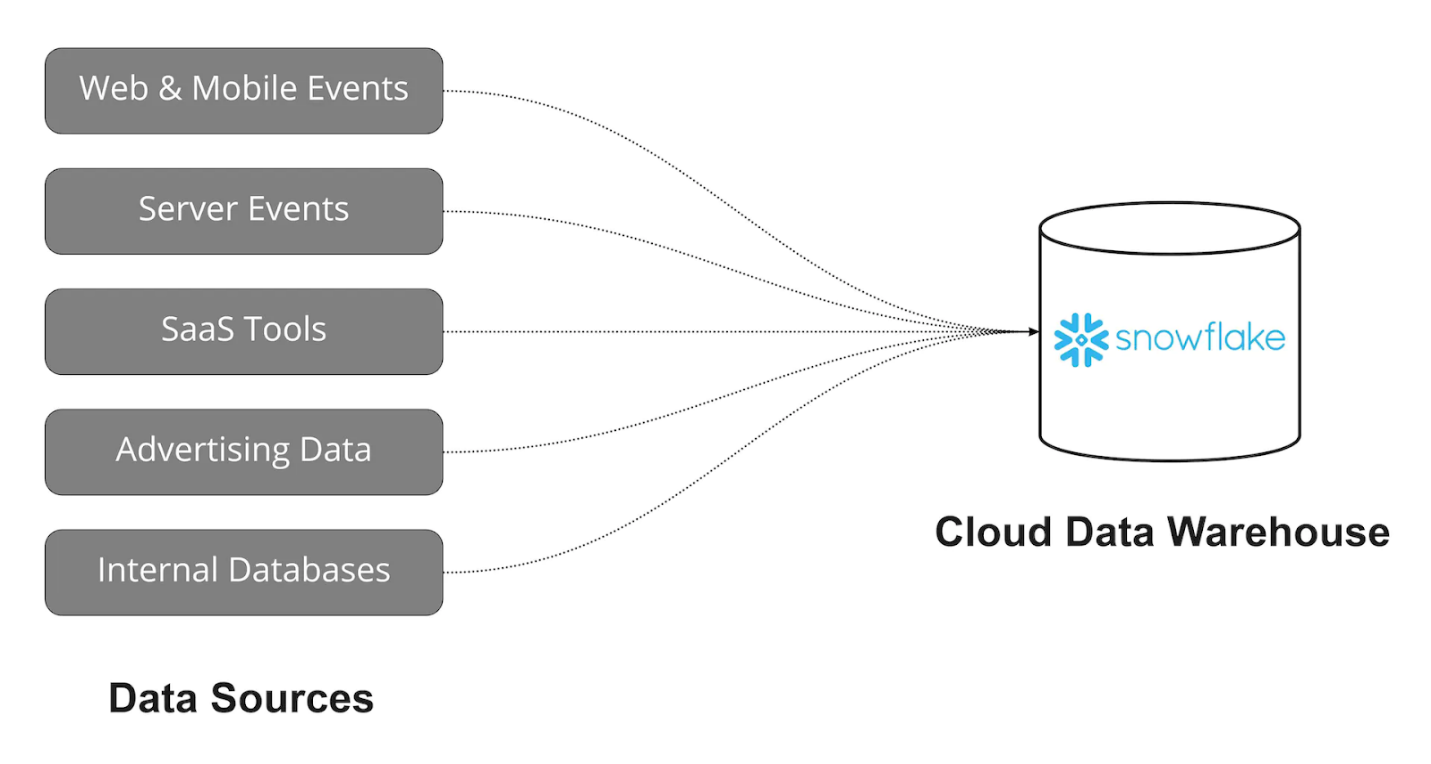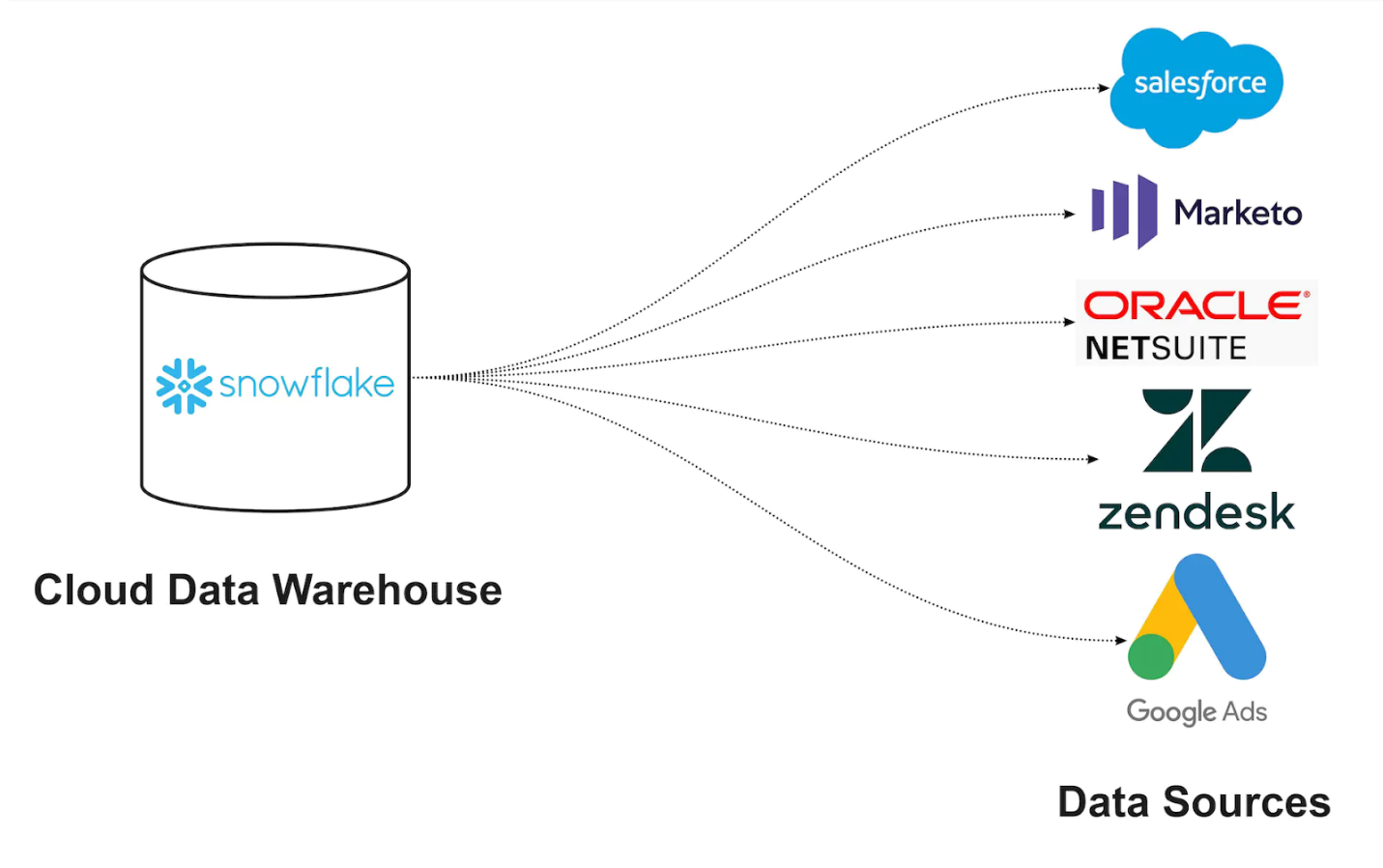Data teams harness ETL pipelines to move data from a source to a destination, i.e., from the data warehouse to a business application like MailChimp or Salesforce. For this reason, the ETL data workflow concept has garnered substantial industry traction.
When asked to move data out of the warehouse, data engineers are perplexed when they have already spent considerable time putting the same data into the warehouse. Without reverse ETL, the data warehouse will become a data repository, as the data inside is only accessible to those who can write SQL commands.
Additionally, data stored in the data warehouse or generated via BI reports only helps users to analyze past events rather than predicting future action. To cope with this problem, data engineers are exploring different strategies to equip non-technical teams with ready-to-use data within an application they use. This process is known as data operationalization. Reverse ETL enables organizations to harness the full potential of their data warehouse through operationalization.
This blog will dive into reverse ETL, how it is different from the ETL pipeline, and how businesses can reap its benefits.

Credited to Source
What is Reverse ETL?
Simply speaking, reverse ETL is the process of moving data from the data warehouse to a business application so that business users can consume it. Reverse ETL effectively bridges the gap between data storage and activation by enabling data migration from a centralized repository to a business application.
The modern data landscape is equipped with plenty of tools for gathering, storing, analyzing, and transferring data. Likewise, businesses today have plenty of options to build their data stack. On top of that, modern data stack assists in building a single source of truth in a data warehouse. This is where reverse ETL steps in. Reverse ETL fetches data from the warehouse and assists organizations in agile decision-making.
Additionally, leveraging data at any stage requires handling different but interrelated lifecycle phases, predominantly transformation, storage, and activation. All it takes is pulling data from source to destination and pushing the same data to a storage location.
From the technical standpoint, reverse ETL is a data processing workflow in which data is extracted from any centralized storage, tailored to the requirements of a specific system such as a SaaS application or CEM, then ingested into a system so the data team can analyze.
Reverse ETL tools provide companies with a better way to sync data from their warehouse to a downstream system by properly handling the abovementioned processes. Above all, these tools allow marketing, sales, customer care, and product teams to ensure optimal utilization of the data from the warehouse.

Credited to Source
Difference Between ETL and Reverse ETL
The traditional ETL process workflow has been around since 1970 with no noticeable change in the data pipeline. For those unfamiliar with the ETL (extract, transform, and load), it is the process in which data is extracted, transformed, and loaded into a destination which might be a data warehouse.

Credited to Source
Some SaaS platforms have simplified this process by providing users with in-built API connectors to extract and load data. On top of that, dedicated transformation tools adopted the ETL process, where the data is transformed once loaded into the data warehouse.
Why can’t we use the conventional ETL to move data out of the warehouse? That’s because ETL is a one-way approach. You can read and write data in the warehouse with ETL data pipelines.
As the name ‘reverse ETL’ implies, users are required to write reverse SQL commands.
Most conventional ETL tools cannot move data out of the warehouse because such tools emphasize merging data and loading them into a table format. If you commit any mistake while loading data, you can only delete a table and then re-ingest the data from scratch.
Furthermore, with reverse ETL, you have to synchronize rows of data. Therefore, you have to compare warehouse data retrieved via a query to the ones you synchronized earlier. Otherwise, you’ll end up wasting a considerable amount of time and money. Since you send data to the downstream business application to streamline workflow, you might sometimes experience sync failures.

Credited to Source
Because reverse ETL assists in data synchronization, companies use reverse ETL tools for time-sensitive processes like marketing campaigns.
Simply speaking, reverse ETL means querying against the data warehouse. However, to execute the reverse ETL process, users are required to write reverse SQL commands. Therefore, moving data out of the data warehouse and putting the same data into operational systems like SaaS tools can be daunting.
How Businesses Can Benefit from the Reverse ETL Process?
In this blog section, we’ll discuss how businesses can reap the benefits of reverse ETL.
Sales
Your product team needs uninterrupted access to the product usage data in the warehouse. For instance, last login data, items in the cart, and page views. Leveraging the power of reverse ETL tools, you can send this data directly to the CRM like Salesforce so your team can take real-time action to strengthen the company’s bottom line.
Running a Targeted Marketing Campaign
Figuring out how to increase ad conversion rate while keeping the customer acquisition cost considerably low is a formidable task. With reverse ETL, you can synchronize customer data in your data warehouse to any marketing channel to run targeted ad campaigns. For instance, you can show ads to only those users who have added products to the cart without checking out.
Product Team
To increase the adoption of your product, you need to tailor it to the end-users requirements as much as you can. To accomplish this task, you have to experiment with different things. However, to make your product more and more user-friendly, your product team must have an answer to a few questions:
- Who are the most active users?
- Which feature of the product do users like the most?
- How to increase conversions?
- When do users usually leave the cart?
With reverse ETL, the product management team can sync essential data about the specific customer to the product database. As a result, they can customize products for the customers’ requirements.
Better Customer Support
Serving the right tickets and keeping the churn rate at a bare minimum should be the goal of the customer support team. Suppose you’ve specified key metrics like annual recurring revenue, churn rate, and customer lifetime value in the data warehouse.
If that is the case, reverse ETL helps synchronize data to the customer support tool; therefore, your support teams can prioritize the high-ticket clients.
Data Operationalization
Operationalization allows data engineers to unlock the full potential of data. From the data analytics standpoint, it means making an abstract concept quantifiable. Similarly, data stored in the warehouse can contribute to your business.
However, when you use the same data in business apps, you turn it into measurable components of business activities like targeted marketing campaigns. Eventually, the results you achieve from data-driven marketing campaigns are substantially higher than a random campaign.
All the departments of an organization can reap the benefits of data operationalization. For instance:
- The finance team can generate a payment plan for B2B customers and send follow-up emails via the automated invoicing software.
- The marketing team can run a re-engagement campaign using MailChimp’s email marketing tool if a customer abandons a shopping cart and does not checkout within 24 hours.
Does Your Company Need a Reverse ETL Tool?
The most critical aspect of reverse ETL tools is their in-built API connectors to operational systems. What if you created API connectors to streamline data flow between your data warehouses and operational systems like HubSpot?
It might seem like a feasible option at first glance. Let’s say your sales team member wants leads scores from the data warehouse. The data engineer will explore different APIs and figure out a way to display lead scores to a custom field in Salesforce.
What if the lead score changes or the sales team wants more information displayed in the business application? Furthermore, tools a specific team uses suddenly change, and the engineering team is required to build one-off integration from scratch. Here are some major problems they will face.
- Creating API connectors from scratch requires a few days or weeks, even if you have the best data engineers on your team. More importantly, your data teams have another task as well.
- API endpoint sometimes fails to handle real-time data transfer. Therefore, you’ll end up reaching the rate limit immediately.
- Your data team needs to manage these API connectors constantly. Therefore, any change in an underlying technology must be adjusted on both ends.
Conclusion
Your data team will waste considerable time and effort building and maintaining API connectors for the reverse ETL. Although it might be cheaper than spending money on reverse ETL tools, wasting your company resources on the least productive work will have its own opportunity cost.
Choosing an appropriate reverse ETL tool from the right vendor will grant you access to in-built API connectors between different components of the data stack. Thus, eliminating the need to build these API connectors on your own.
The post A Beginner’s Guide to Reverse ETL: Concept and Use Cases appeared first on Datafloq.

